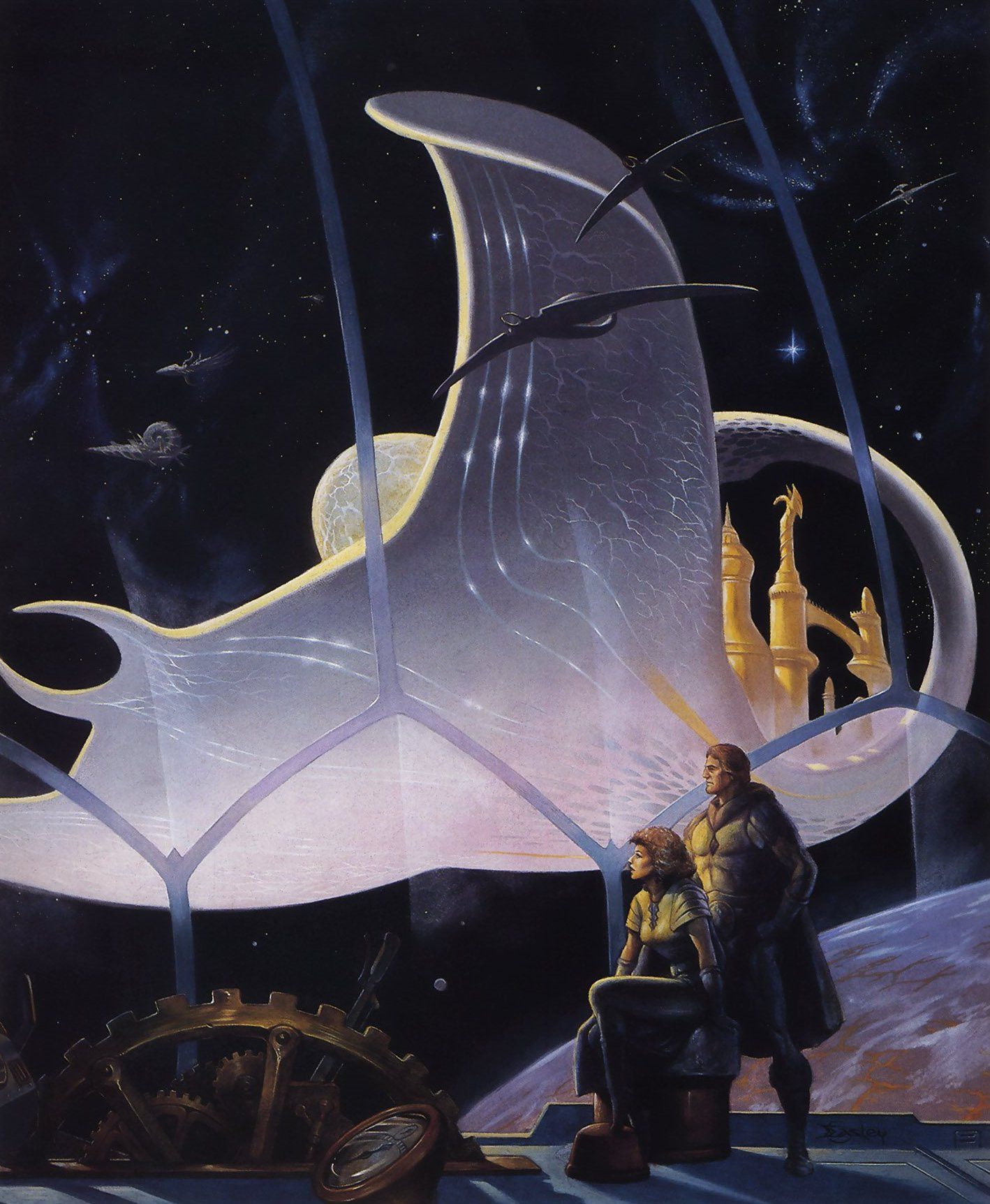|
|
|
|
|
|
|
|
|
|
|
|
The Known
Planes of Existence, as depicted in APPENDIX
IV of the
PH,
offer nearly endless possibilities for AD&D
play, <>
although some of these new
realms will no longer be fantasy as found in
swords & sorcery or
myth but verge an that of science fiction, horror, or just
about anything else desired.
How so? The known planes are a part of the
"multiverse". In the Prime
Material Plane are countless suns, planets,
galaxies, universes. So
too there are endless parallel worlds. What then of
the Outer Planes? Certainly,
they can be differently populated if not substantially
different in form.

Spells, magic devices, artifacts,
and relics are known ways to travel to the
planes. You can add machines
or creatures which will also allow such
travel. As far as the universe
around your campaign world goes, who is to
say that it is not possible
to mount a roc and fly to the moon(s)? ar perhaps
to another planet? Again,
are the stars actually suns at a distance? or are
they the tiny lights of
some vast dome? The hows and wherefores are
yours to handle, but more
important is what is on the other end of the
route.
For those of you who haven't
really thought abaut it, the so-called planes
are your ticket to creativity,
and I mean that with a capital C! Everything
can be absolutely different,
save for those common denominators
necessary to the existence of the player characters coming to the plane.
Movement and scale can be
different; so can combat and morale.
Creatures can have more
or different attributes.
As long as the player characters
can somehow relate to it all, then it will work.
This is not to say that
you are expected
to actually make each and
every plane a totally new experience --
an impossibly tall order.
It does mean that you can put your imagination to
work on devising a single
extraordinary plane. For the rest, simply use
AD&D
with minor quirks, petty differences, and so forth. If your players
wish to spend most of their
time visiting other planes (and this could come
to pass after a year or
more of play) then you will be hard pressed unless
you rely upon other game
systems to fill the gaps. Herein I have recommended
that BOOT
HILL and GAMMA WORLD be used in
campaigns.
There is also METAMORPHOSIS
ALPHA,

TRACTICS,

and all sorts of other
offerings which can be converted
to man-for-man role-playing scenarios.
While as of this particular
writing there are no commercially available
"other planes" modules,
I am certain that there will be soon -- it is simply
too big an opportunity to
pass up, and the need is great.
Astral and ethereal travel
are not difficult, as the systems for encounters
and the chances for the
hazards of the psychic wind and ether cyclone are
but brief sections of APPENDIX
C: RANDOM MONSTER ENCOUNTERS,
easily and quickly handled.
Other forms of travel, the risks and hazards
thereof, you must handle
as you see fit. For instance, suppose that you
decide that there is a breathable
atmosphere which extends from the earth
to the moon, and that any
winged steed capable of flying fast and far can
carry its rider to that
orb. Furthermore, once beyond the normal limits of
earth's atmosphere, gravity
and resistance are such that speed increases
dramatically, and the whole
journey will take but a few days. You must
then decide what will be
encountered during the course of the trip - perhaps
a few new creatures in addition
to the standard ones which you
deem likely to be between
earth and moon.
Then comes what conditions
will be like upon Luna, and what will be
found there, why, and so
on. Perhaps here is where you place the
gateways to yet other worlds.
In short, you devise the whole schema just as
you did the campaign, beginning
from the dungeon and environs outward
into the broad world - in
this case the universe, and then the multiverse.
You need do no more than
your participants desire, however. If your
players are quite satisfied
with the normal campaign setting, with occasional
side trips to the Layers
of the Abyss or whatever, then there is no
need to do more than make
sketchy plans for the eventuality that their
interests will expand. In
short, the planes are there to offer whatever is
needed in the campaign.
Use them as you will.

Quote:
Originally Posted by Jdvn1
Anyway, I have an Origin
of D&D question now. Nowadays, there's d20 Modern, d20 Future, et cetera.
I don't keep up with all the different varieties. My question is this:
How much of this did you think of at the beginning? When you made OAD&D,
did you think, "Oh, we could make modern-day or futuristic classes too
and have a different setting!"? Did you make plans for that sort of thing
or were you trying to keep it fantasy-only?

The fact is I wanted to
be able to mix genres--not use the A/D&D rules to play other
genres, but means of mixing genres.
Thus we had fantasy forces
comprised of orcs led by an Evil cleric meeting and fighting with a Nazi
anti-partizan company, and fought the battle out on a table top.
I had PCs sent to the Starship
Warden to tangle with Metamorphosis Alpha characters.
No need to go on, you get
the idea.
Cheers,
Gart
